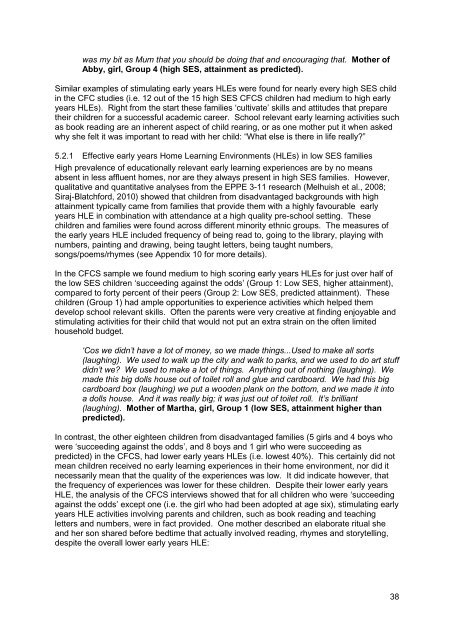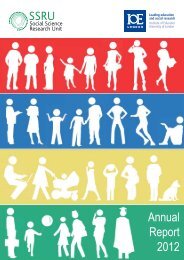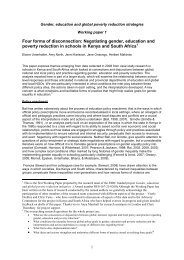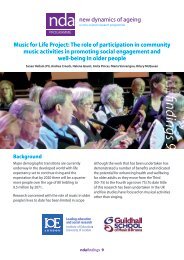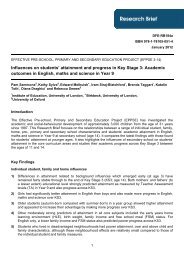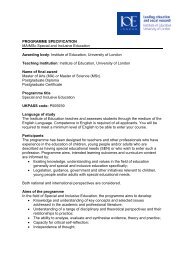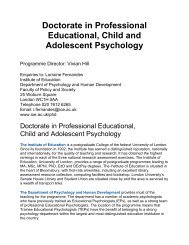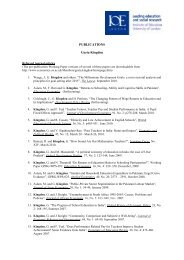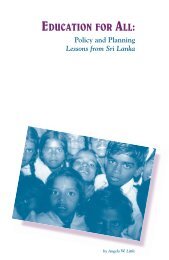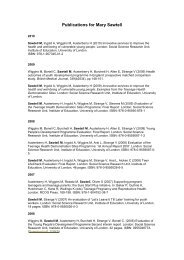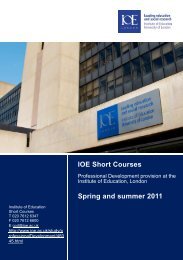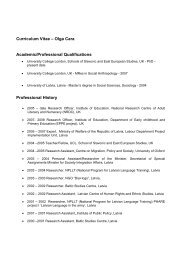Research report - Institute of Education, University of London
Research report - Institute of Education, University of London
Research report - Institute of Education, University of London
You also want an ePaper? Increase the reach of your titles
YUMPU automatically turns print PDFs into web optimized ePapers that Google loves.
was my bit as Mum that you should be doing that and encouraging that. Mother <strong>of</strong><br />
Abby, girl, Group 4 (high SES, attainment as predicted).<br />
Similar examples <strong>of</strong> stimulating early years HLEs were found for nearly every high SES child<br />
in the CFC studies (i.e. 12 out <strong>of</strong> the 15 high SES CFCS children had medium to high early<br />
years HLEs). Right from the start these families „cultivate‟ skills and attitudes that prepare<br />
their children for a successful academic career. School relevant early learning activities such<br />
as book reading are an inherent aspect <strong>of</strong> child rearing, or as one mother put it when asked<br />
why she felt it was important to read with her child: “What else is there in life really?”<br />
5.2.1 Effective early years Home Learning Environments (HLEs) in low SES families<br />
High prevalence <strong>of</strong> educationally relevant early learning experiences are by no means<br />
absent in less affluent homes, nor are they always present in high SES families. However,<br />
qualitative and quantitative analyses from the EPPE 3-11 research (Melhuish et al., 2008;<br />
Siraj-Blatchford, 2010) showed that children from disadvantaged backgrounds with high<br />
attainment typically came from families that provide them with a highly favourable early<br />
years HLE in combination with attendance at a high quality pre-school setting. These<br />
children and families were found across different minority ethnic groups. The measures <strong>of</strong><br />
the early years HLE included frequency <strong>of</strong> being read to, going to the library, playing with<br />
numbers, painting and drawing, being taught letters, being taught numbers,<br />
songs/poems/rhymes (see Appendix 10 for more details).<br />
In the CFCS sample we found medium to high scoring early years HLEs for just over half <strong>of</strong><br />
the low SES children „succeeding against the odds‟ (Group 1: Low SES, higher attainment),<br />
compared to forty percent <strong>of</strong> their peers (Group 2: Low SES, predicted attainment). These<br />
children (Group 1) had ample opportunities to experience activities which helped them<br />
develop school relevant skills. Often the parents were very creative at finding enjoyable and<br />
stimulating activities for their child that would not put an extra strain on the <strong>of</strong>ten limited<br />
household budget.<br />
„Cos we didn‟t have a lot <strong>of</strong> money, so we made things...Used to make all sorts<br />
(laughing). We used to walk up the city and walk to parks, and we used to do art stuff<br />
didn‟t we? We used to make a lot <strong>of</strong> things. Anything out <strong>of</strong> nothing (laughing). We<br />
made this big dolls house out <strong>of</strong> toilet roll and glue and cardboard. We had this big<br />
cardboard box (laughing) we put a wooden plank on the bottom, and we made it into<br />
a dolls house. And it was really big; it was just out <strong>of</strong> toilet roll. It‟s brilliant<br />
(laughing). Mother <strong>of</strong> Martha, girl, Group 1 (low SES, attainment higher than<br />
predicted).<br />
In contrast, the other eighteen children from disadvantaged families (5 girls and 4 boys who<br />
were „succeeding against the odds‟, and 8 boys and 1 girl who were succeeding as<br />
predicted) in the CFCS, had lower early years HLEs (i.e. lowest 40%). This certainly did not<br />
mean children received no early learning experiences in their home environment, nor did it<br />
necessarily mean that the quality <strong>of</strong> the experiences was low. It did indicate however, that<br />
the frequency <strong>of</strong> experiences was lower for these children. Despite their lower early years<br />
HLE, the analysis <strong>of</strong> the CFCS interviews showed that for all children who were „succeeding<br />
against the odds‟ except one (i.e. the girl who had been adopted at age six), stimulating early<br />
years HLE activities involving parents and children, such as book reading and teaching<br />
letters and numbers, were in fact provided. One mother described an elaborate ritual she<br />
and her son shared before bedtime that actually involved reading, rhymes and storytelling,<br />
despite the overall lower early years HLE:<br />
38


